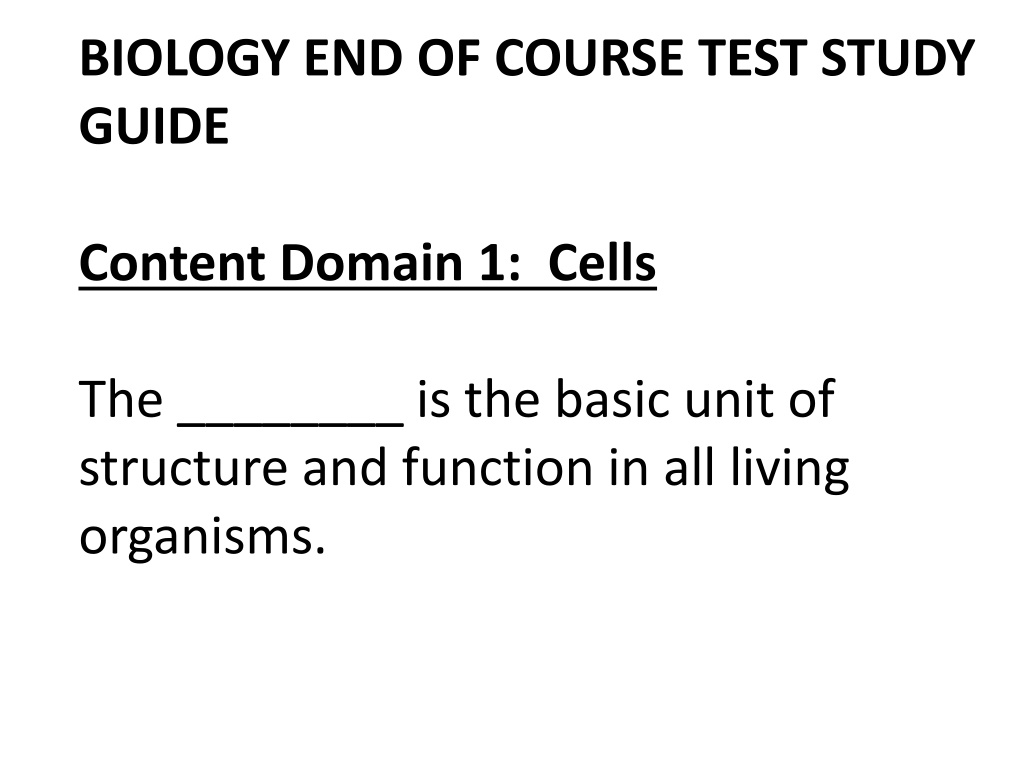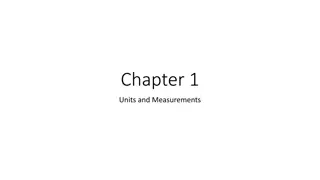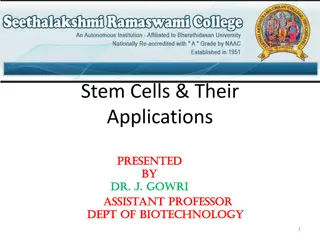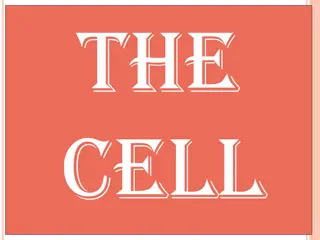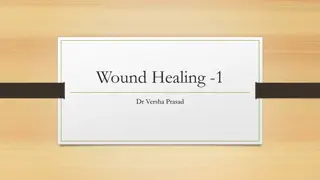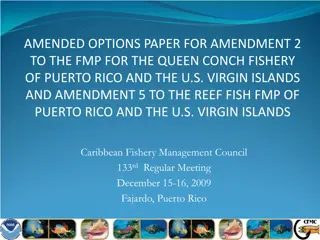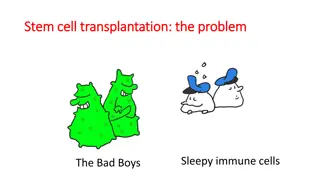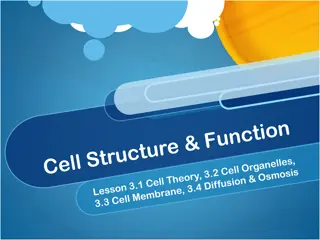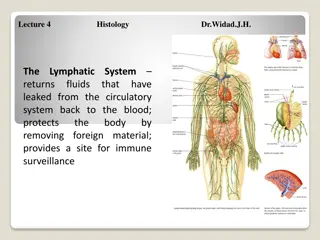Understanding Cells: The Basic Units of Life
Exploring the fundamental importance of cells in living organisms, this study guide delves into the structure and function of eukaryotic and prokaryotic cells. It highlights the distinction between these cell types, their respective characteristics, and the defining features of living things. Emphasizing key concepts like cellular organization, membrane-bound organelles, and the role of the cell membrane, this guide sheds light on the essential components that make life possible at a cellular level.
Download Presentation

Please find below an Image/Link to download the presentation.
The content on the website is provided AS IS for your information and personal use only. It may not be sold, licensed, or shared on other websites without obtaining consent from the author. Download presentation by click this link. If you encounter any issues during the download, it is possible that the publisher has removed the file from their server.
E N D
Presentation Transcript
BIOLOGY END OF COURSE TEST STUDY GUIDE Content Domain 1: Cells The ________ is the basic unit of structure and function in all living organisms.
BIOLOGY END OF COURSE TEST STUDY GUIDE Content Domain 1: Cells The _cell_______ is the basic unit of structure and function in all living organisms.
Eukaryotic cell - Animal Cell Prokaryotic cell Prokaryotic cell- - Bacteria Eukaryotic cell Eukaryotic cell- Plant cell Also Eukaryotic: Protists and Fungi
If a cell has a nucleus and membrane bound organelles, it is said to be ____________________. If a cell does not have a nucleus or membrane bound organelles, it is said to be ______________________. Both types of cells have DNA and ribosomes. There are only 2 kingdoms whose members contain prokaryotic cells. They are ______________________ and ____________________. Organisms with prokaryotic cells are all __________ celled organisms where as eukaryotes can be either __________ celled or __________celled organisms.
If a cell has a nucleus and membrane bound organelles, it is said to be ____eukaryotic_____________________. If a cell does not have a nucleus or organelles, it is said to be _____prokaryotic____________________. There are only 2 kingdoms whose members contain prokaryotic cells. They are __Eubacteria_______________ and __Archaebacteria_______________. Organisms with prokaryotic cells are all _one______ celled organisms where as eukaryotes can be either _one_____ celled or __many______celled organisms.
Which of the following are characteristics of living things? (Circle correct characteristics) Reproduction Gas exchange Growth Assimilation of materials Respond to stimuli Definite shape Movement Take in energy The ________________ is the outer boundary of the cell and it controls what enters and leaves the cell.
Which of the following are characteristics of living things? (Circle correct characteristics) Reproduction growth Take in energy assimilation of materials respond to stimuli Definite shape Gas exchange movement The __cell membrane_____________ is the outer boundary of the cell and it controls what enters and leaves the cell.
Label the following structures in the cell (plasma) membrane below: 2. The parts inside of a cell which perform a specific function for the cell are known as ________________.
Label the following structures in the cell (plasma) membrane below: Protein 2. Lipids The parts inside of a cell which perform a specific function for the cell are known as ________________. Organelles
Fill out the table below on the Cell Parts. Cell Part Function Energy center or "powerhouse" of the cell. Turns food energy into useable chemical energy (ATP). This is the site for Cellular Respiration. Site for making proteins Processes, packages and secretes proteins (cell s post office) Contains digestive enzymes, breaks things down Transport, "intracellular highway" Stores water or other substances (Plants- 1 large one; Animals-several small ones. Uses sunlight to create food, site of photosynthesis (only found in algae and plant cells) Provides additional support (plant, fungi, and bacteria cells) Jelly-like fluid interior of the cell the "control center" of the cell, contains the cell's DNA (chromosomes)
Fill out the table below on the Cell Parts. Cell Part Function Energy center or "powerhouse" of the cell. Turns food into useable energy (ATP). This is the site for Cellular Respiration. mitochondria ribosomes Make protein Golgi apparatus Processes, packages and secretes proteins (cell s post office) lysosomes Contains digestive enzymes, breaks things down Endoplasmic reticulum Transport, "intracellular highway" vacuole Stores water or other substances (Plants- 1 large one Animals-several small ones. chloroplasts Uses sunlight to create food, site of photosynthesis (only found in plant cells) Cell wall Provides additional support (plant, fungi, and bacteria cells) cytoplasm Jelly-like fluid interior of the cell nucleus the "control center" of the cell, contains the cell's DNA (chromosomes)
Living things maintain a balance between materials entering and exiting the cell. Their ability to maintain this balance is called _____________________. (You can also apply this term to the whole organism when discussing maintenance and regulation of body temperature, hormone levels, sweating vs. shivering, etc ). The movement of substances across the cell membrane from an area of high concentration to an area of low concentration is known as _________________________. The diagram below is illustrating the process of ______________.
Living things maintain a balance between materials entering and exiting the cell. Their ability to maintain this balance is called _homeostasis. (You can also apply this term to the whole organism when discussing maintenance and regulation of body temperature, hormone levels, sweating vs. shivering, etc ). The movement of substances across the cell membrane from an area of high concentration to an area of low concentration is known as _passive transport (diffusion). The diagram below is illustrating the process of osmosis (if water is moving).
The following diagrams represent different solutions that can affect the rate of osmosis. Label the solutions as being either hypotonic, hypertonic , or isotonic to the cells in the solutions. This solution is __________________ to the cell. This solution is ______________ to the cell. This solution is ______________ to the cell.
The following diagrams represent different solutions that can affect the rate of osmosis. Label the solutions as being either hypotonic, hypertonic , or isotonic to the cells in the solutions. This solution is _hypertonic____ to the cell. This solution is __Isotonic___ to the cell. This solution is _hypotonic to the cell.
The contractile vacuole inside of some protists like the paramecium below maintains osmotic balance (amount of water inside the cell) by pumping out excess ____________________________. ____________________ is the type of membrane transport which requires energy. Bulk transport into the cell is known as ____________, and bulk transport out of the cell is known as _________.
The contractile vacuole inside of some protists like the paramecium below maintains osmotic balance (amount of water inside the cell) by pumping out excess _water___. _Active transport_ is the type of membrane transport which requires energy. Bulk transport into the cell is known as _endocytosis, and bulk transport out of the cell is known as exocytosis.
____________ are special proteins that speed up the rate of chemical reactions, by lowering activation energy (energy required to start a reaction). The ______________ is the substance an enzyme acts upon. The enzyme and substrate fit together like a __________________________. This interlocking fit makes enzymes act only on specific substrates. Label the diagram below with the following terms: Enzyme/substrate complex, substrate, enzyme, product . __________________ __________________
. Enzymes are special proteins that speed up the rate of chemical reactions, by lowering activation energy (energy required to start a reaction). The substrate is the substance an enzyme acts upon. The enzyme and substrate fit together like a lock and key. This interlocking fit makes enzymes act only on specific substrates. Label the diagram below with the following terms: Enzyme/substrate complex, substrate, enzyme, product substrate product Enzyme substrate complex enzyme
If it ends in ase, is probably an ________________, and if a word ends in ose it is a __________________. The area in which a substrate molecule fits into an enzyme is known as the _____________site. Fill in the table on the 4 major biomolecules: Biomolecule Monomer Function 1. Carbohydrate 2. Glycerol and fatty acids Some are important structural components of living things- some serve as enzymes . 3. 4. Nucleic acids
If it ends in ase, is probably an enzyme, and if a word ends in ose it is a sugar. The area in which a substrate molecule fits into an enzyme is known as the active site. Fill in the table on the 4 major biomolecules: Biomolecule Monomer Function 1. Carbohydrate Monosaccharides (simple sugars) Provide building materials and energy 2. Lipid Glycerol and fatty acids Store energy Some are important structural components of living things- some serve as enzymes . Amino acids 3. Protein Contains and translates the genetic code Nucleotides 4. Nucleic acids
Content Domain 2: Organisms ATP-Adenosine Triphosphate is a special molecule that stores and releases the energy in its bonds when the cell needs it. Below is a diagram showing the ATP-ADP cycle. On the lines beside the diagram write either energy released for chemical reactions or energy supplied through cellular respiration. ATP ___________________________ ___________________________ ADP + P The process in which plants utilize sunlight energy into chemical energy in the form of glucose is called ____________. The process above takes place in the ________________ of the plant cell.
Content Domain 2: Organisms ATP-Adenosine Triphosphate is a special molecule that stores and releases the energy in its bonds when the cell needs it. Below is a diagram showing the ATP-ADP cycle. On the lines beside the diagram write either energy released for chemical reactions or energy supplied through cellular respiration. ATP _energy supplied through cellular resspiration_ The process in which plants utilize sunlight energy into chemical energy in the form of glucose is called photosynthesis. The process above takes place in the chloroplasts of the plant cell. Energy released for chemical reactions ADP + P
Fill in the summary reaction for photosynthesis below with the correct reactants and products. Use the following terms: water, carbon dioxide, glucose, oxygen, CO2, H2O, C6H12O6, O2 (Place symbols on the top lines and words on the bottom.) ____+ ____ _________________ _______________ The process by which organisms break down glucose in order to release the energy in it is known as ___________________. This process takes place in the ___________________ of the cell. ______+ _____ sunlight
Fill in the summary reaction for photosynthesis below with the correct reactants and products. Use the following terms: water, carbon dioxide, glucose, oxygen, CO2, H2O, C6H12O6, O2 (Place symbols on the top lines and words on the bottom.) sunlight CO2 + H2O carbon dioxide+ water Glucose + oxygen The process by which organisms break down glucose in order to release the energy in it is known as cellular respiration. This process takes place in the mitochondria of the cell. C6H12O6 + O2
Fill in the summary reaction for cellular respiration below with the correct reactants and products. Use the following terms: water, carbon dioxide, glucose, oxygen, CO2, H2O, C6H12O6, O2 (Place symbols on the top lines and words on the bottom.) ________ + ________ _________________________ ________ + ________ ____________________
Fill in the summary reaction for cellular respiration below with the correct reactants and products. Use the following terms: water, carbon dioxide, glucose, oxygen, CO2, H2O, C6H12O6, O2 (Place symbols on the top lines and words on the bottom.) C6H12O6 + O2 CO2 + H2O glucose + oxygen carbon dioxide and water
____________________________ is the branch of biology which deals with the grouping and naming of organisms. Carolus Linneaus developed the two word system to name organisms known as ______________________________. The first word of a scientific name is the __________________________ name and the second word is the __________________________ name. There are _____________ taxa (classification categories) in Linneaus system. List them in order from largest to smallest. 1. 2. 3. 4. 5. 6. 7.
Taxonomy is the branch of biology which deals with the grouping and naming of organisms. Carolus Linneaus developed the two word system to name organisms known as binomial nomenclature. The first word of a scientific name is the genus name and the second word is the species name. There are seven taxa (classification categories) in Linneaus system. List them in order from largest to smallest. 1. Kingdom 2. Phylum 3. Class 4. Order 5. Family 6. Genus 7. Species
In the modern day classification system there are _________ kingdoms and ________ domains. Correctly identify the kingdoms given the descriptions in the table below. Provide an example organism in each kingdom.
In the modern day classification system there are six kingdoms and three domains. Correctly identify the kingdoms given the descriptions in the table below. Provide an example organism in each kingdom.
Description Example Organism Kingdom Consumers that stay put. They have eukaryotic cells. They may be unicellular or multicellular. They decompose dead organisms and waste from the environment. Multicellular eukaryotes that photosynthesize. Have cellulose cell walls. Mainly found in extreme environments. Some of these prokaryotic cells like extremely hot temperatures and areas of high salt content. What is the only single celled organism in this group? Multicellular consumers. They do not contain cell walls. Most have the ability to move. Most diverse kingdom of organisms. They may be unicellular or multicellular. They live in moist environments. Some are plant-like, some animal-like, some fungus-like. This group of prokaryotes can be both beneficial and harmful. Some cause diseases while others are used in the food industry and are decomposers.
Description Example Organism Kingdom Consumers that stay put. They have eukaryotic cells. They may be unicellular or multicellular. They decompose dead organisms and waste from the environment. Multicellular eukaryotes that photosynthesize. Have cellulose cell walls. Mainly found in extreme environments. Some of these prokaryotic cells like extremely hot temperatures and areas of high salt content. Multicellular consumers. They do not contain cell walls. Most have the ability to move. Most diverse kingdom of organisms. They may be unicellular or multicellular. They live in moist environments. Some are plant-like, some animal-like, some fungus-like. This group of prokaryotes can be both beneficial and harmful. Some cause diseases while others are used in the food industry and are decomposers. What is the only single celled organism in this group? Yeast Apple tree Methanogens Fungi Plantae Archaebacteria Animalia Protista YOU!! Protozoa,Algae Slime Mold Eubacteria E. coli
Match the animal phylum characteristics with the correct phylum name: ____Contain no specialized tissue. Have many pores. ____ Bodies with radial symmetry. Stinging cells ____ Flat worms. Only one body opening for digestive tract ____ Round worms. First group with 2 body openings ____ Segmented worms. First group with complete Digestive system. ____ snails, squid, clams, oysters, slugs. Soft-body ____ Jointed appendages and exoskeletons. ____ spiny skin ____ notochord, gill slits, tail A. Platyhelminthes B. Chordata C. Nematoda D. Arthropoda E. Porifera F. Cnidaria G. Annelida H. Echinodermata I. Mollusa
Match the animal phylum characteristics with the correct phylum name: _E__Contain no specialized tissue. Have many pores. _F__ Bodies with radial symmetry. Stinging cells _A__ Flat worms. Only one body opening for digestive tract _C__ Round worms. First group with 2 body openings _G_ Segmented worms. First group with complete Digestive system. _I__ snails, squid, clams, oysters, slugs. Soft-body _D__ Jointed appendages and exoskeletons. _H__ spiny skin _B__ notochord, gill slits, tail A. Platyhelminthes B. Chordata C. Nematoda D. Arthropoda E. Porifera F. Cnidaria G. Annelida H. Echinodermata I. Mollusa
In the table below, write in the correct Vertebrate class. Class Description Must return to water to reproduce. Obtain oxygen with gills when young and with lungs and through skin as an adult. Have hollow bones and feathers. Are jawless fish with skeletons made of cartilage. Have skeletons of cartilage. Sharks, skates and rays are examples. The first group to produce an amniotic egg. Have tough scaly skin. Feed their young milk. Have hair as a body covering Bony fish.
37. In the table below, write in the correct Vertebrate class. Class Description Must return to water to reproduce. Obtain oxygen with gills when young and with lungs and through skin as an adult. Have hollow bones and feathers. Amphibian Aves Agnatha Are jawless fish with skeletons made of cartilage. Have skeletons of cartilage. Sharks, skates and rays are examples. The first group to produce an amniotic egg. Have tough scaly skin. Feed their young milk. Have hair as a body covering Chondrichthyes Reptile Mammal Bony fish. Osteichthyes
Organism that can maintain a constant body temperature regardless of external temperature are known as ________________________. Also known as warm-blooded. Organisms whose body temperature is similar to the temperature of the environment are known as ______________________. Also known as cold-blooded. ____________________ plants have no vascular tissue, no roots, stems, or leaves. Ex. Mosses, hornworts, and liverworts. __________________________ plants have vascular tissue to transport food and water. Ex. Ferns, grass, trees, bushes, etc . The type of vascular tissue that conducts water from the roots to the leaves is known as ___+_____________________. The type of vascular tissue that conducts sugar from the leaves to the roots is known as _________________________.
Organism that can maintain a constant body temperature regardless of external temperature are known as Endothermic. Also known as warm-blooded. Organisms whose body temperature is similar to the temperature of the environment are known as ectothermic. Also known as cold-blooded. bryophytes plants have no vascular tissue, no roots, stems, or leaves. Ex. Mosses, hornworts, and liverworts. tracheophytes plants have vascular tissue to transport food and water. Ex. Ferns, grass, trees, bushes, etc . The type of vascular tissue that conducts water from the roots to the leaves is known as xylem. The type of vascular tissue that conducts sugar from the leaves to the roots is known as phloem.
Label the flower below using the following terms: Petal, Pistil, stamen, ovary, ovule, sepal, stem
Label the flower below using the following terms: Petal, Pistil, stamen, ovary, ovule, sepal, stem P- Pistil H-stamen D-petals L-ovary O-ovules C-sepals B-stem
Label the 3 parts of the pistil, and the 2 parts of the stamen in the drawings below.
Label the 3 parts of the pistil, and the 2 parts of the stamen in the drawings below. A-Anther F-filament J-stigma K-style L-ovary O-ovule
The ___________________ is a waxy substance that reduces water loss in plants. _____________________ are openings in the epidermis of a leaf that allows for gas exchange and transpiration.
The cuticle is a waxy substance that reduces water loss in plants. stomata are openings in the epidermis of a leaf that allows for gas exchange and transpiration.
Content Domain III: Genetics. Chromosomes are made up of the organic molecules called _____________________acids. There are 2 kinds of nucleic acids ____________ and _____________. How do these 2 kinds differ? 1. 2. 3. 4.
Chromosomes are made up of the organic molecules called __nucleic______ acids. There are 2 kinds of nucleic acids __DNA_____ and _RNA_______. How do these 2 kinds differ? 1.DNA is double stranded & RNA is single stranded 2. DNA has Thymine & RNA has Uracil 3.DNA has deoxyribose sugar & RNA has ribose sugar 4.DNA has the genetic code & RNA translates the genetic code.
List the four kinds of nitrogenous bases found in the DNA molecule showing which bonds to which. List the four kinds of nitrogenous bases found in the RNA molecule showing which bonds to which. Name the 3 kinds of RNA ______________________, ______________________, and ______________________________. Know the function of each.
List the four kinds of nitrogenous bases found in the DNA molecule showing which bonds to which. Adenine, Thymine, Guanine, & Cytosine List the four kinds of nitrogenous bases found in the RNA molecule showing which bonds to which. Adenine, Uracil, Guanine, & Cytosine. Name the 3 kinds of RNA _mRNA_____________, __tRNA_________________, and ___rRNA_________. Know the function of each.
The DNA molecule has the shape of a _________________________________. The RNA molecule is _________________ stranded. The process by which DNA makes a copy of itself is known as ___________________________ and it takes place during ________________________ of the cell cycle. Where does the above process take place in the cell?_________________________
